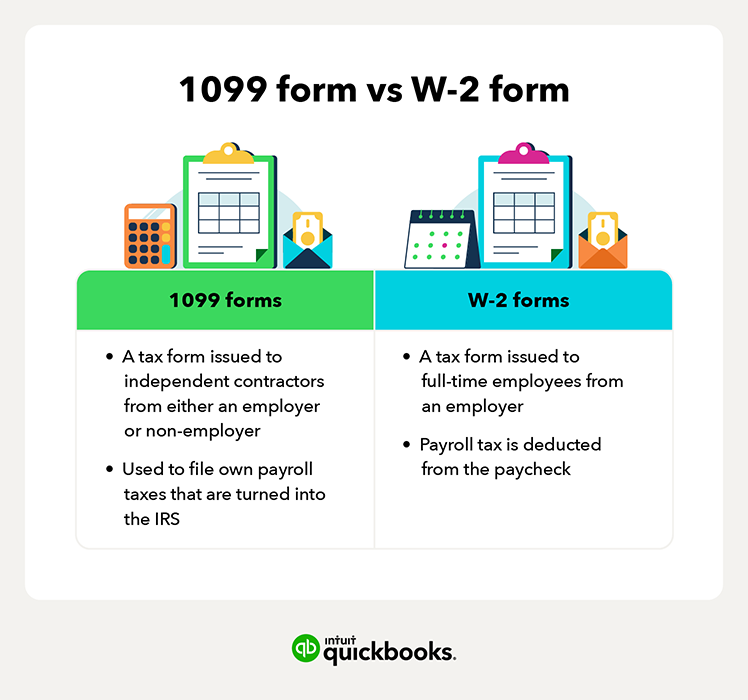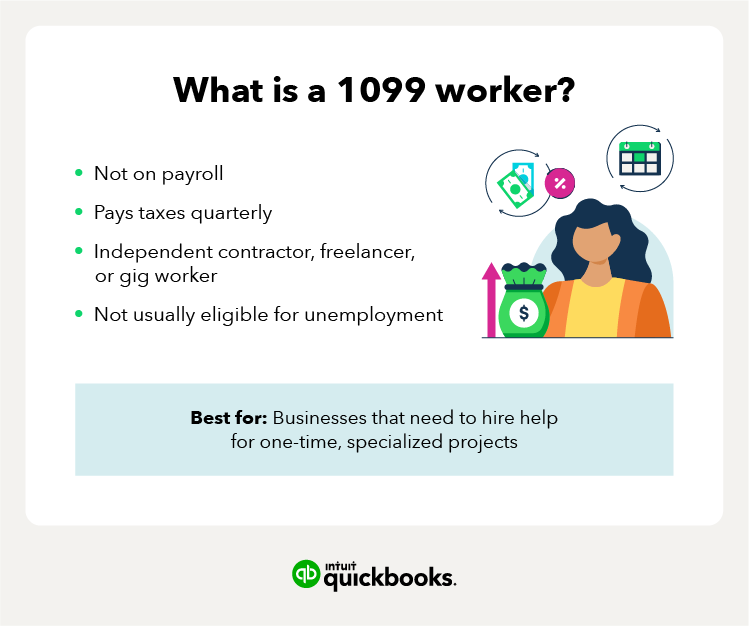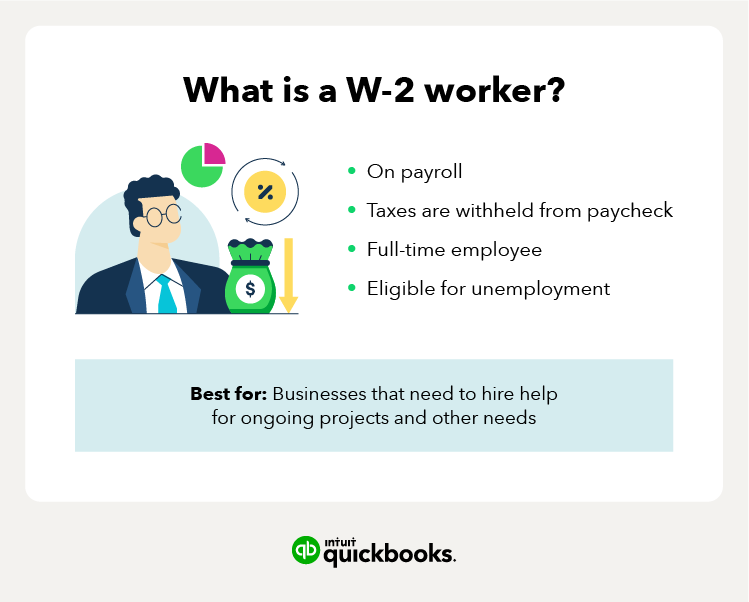
September 9, 2022
September 9, 2022
When it comes to adding workers to your business, the number of forms you’re faced with can seem endless. 1099 workers are also known as self-employed workers or independent contractors. These workers receive a 1099 form to report their income on their tax returns.
W-2 workers are more simply known as employees. Your company employs these workers directly, and they receive regular pay and employee benefits. The company uses a W-2 tax form to report compensation annually and payroll taxes that are withheld from their employee’s pay.
Read on to explore the differences and benefits of 1099 vs W-2 regarding both the forms and workers, as well as other considerations to know before hiring a position for your business.
1099 vs W-2 forms

1099 and W-2 forms are both common small business tax forms, but the differences include who receives the form and how they get handled regarding tax rates and practices. Below, we’ll explain these two forms in depth.
What are 1099 forms?
Form 1099 is a document stating that a nonemployer paid money to an individual or business. There are many different types of 1099 forms, but the most common are 1099-NEC and 1099-MISC. Form 1099-NEC gathers information from nonemployee earnings.
These forms — typically issued to freelancers and independent contractors — report wages without taxes withheld, such as Medicare and Social Security, to the IRS.
As of 2020, those who earn payments of over $600 for non-employee compensation will receive the 1099-NEC form — this will be replacing Form 1099-MISC.
What are W-2 forms?
W-2 forms are tax forms that report all payments made to employees within a year. The employer provides these forms to all employees at the end of the calendar year. The information on a W-2 reports:
- State income: The amount withheld for state income tax purposes.
- Medicare and social security income: The amount of money the employer withholds to pay FICA taxes.
- Taxable income: The amount an employee made that year and the amount withheld for federal taxes.
This information on the W-2 form is necessary to file income tax returns during tax season.
Why it’s important to know the differences
It’s important to know the difference between 1099 independent contractors and W-2 employees for a few reasons:
- Misclassifying an employee as an independent contractor may lead to hefty financial penalties. These penalties can include:
- Up to a $1,000 fine if misconduct occurs.
- $50 for each misclassified W-2 form.
- Penalties of 1.5% of the wages of withheld income taxes.
- 40% of the FICA taxes (Social Security and Medicare) that weren’t withheld from the employee.
- Calculating taxes incorrectly: Employee classifications affect how both you and your workers are taxed. You’re required to withhold income taxes and pay taxes on the wages you pay to W-2 employees. You don’t usually have to withhold or pay taxes on the payments you make to 1099 contractors.
- Mistaking your working relationship: Employee classifications determine how much control you have over a worker’s schedule, payment, and other aspects of their job. Independent contractors define when, how, and where they work. Employees work according to your schedule and policies.
Every small business owner should understand the differences between these classifications and when to hire a W-2 versus a 1099 worker. But the differences aren’t always clear. If you’re still murky on the details, you’re not alone. Let’s take a closer look at each classification when it comes to both forms and workers.
How to determine if a worker receives a W-2 or 1099 Form
There is no magic formula to determine whether a worker is an independent contractor or an employee. But the IRS does offer some guidance. Three categories determine the degree of control you have over a worker:
- Behavioral: Does the company control or have the right to control what the worker does and how the worker does their job?
- Financial: Does the company or payer control the business aspects, like how it pays the worker? Are the worker’s expenses reimbursed? Who provides the tools and supplies needed to get the job done?
- Type of relationship: Do you have employee policies or offer employee-type benefits like pension, insurance, and vacation pay? Is the work performed a key aspect of the business? Will the relationship continue once the work is done?
As a business owner, it’s up to you to determine whether a worker is an employee or an independent contractor. Be sure to check in with your state, since each has its own rules and regulations pertaining to worker classifications.
Some of your answers to the above questions may indicate the worker is an employee. Others may indicate the worker is a 1099 contractor. It’s up to you to consider all the factors, determine the extent of control over the worker, and thoroughly document your final decision.
Can a worker be both a 1099 and a W-2?
Yes, according to the IRS. There may be instances where a worker serves as an independent contractor and an employee for the same entity. Workers can be both, either concurrently or at separate times, in the same calendar year. The IRS presents the following example:
“Joe is a custodian who works for a county public school. The county views him as an employee and issues him a Form W-2 for these services. He also has a business that he owns and operates that provides snow plowing services on nights and weekends. Any snow plowing services he performs for the county are separate and distinct from his services as a custodian. Therefore, the county should treat him as an independent contractor for his snow plowing business. The county reports this income on a Form 1099-Misc in Box 7, Nonemployee Compensation.”
Note: Filing a 1099 and a W-2 for the same worker could result in a tax audit. The IRS will perform these audits on employers if they suspect an employee was misclassified.
1099 vs. W-2 taxes
Your tax obligations vary between 1099 contractors and W-2 employees. You pay 1099 workers per the terms of their contract. At the end of the year, they receive a 1099 form to report their income on their taxes.
1099 tax obligations
As a business owner, you’re not on the hook to withhold or pay taxes for 1099 contractors. These workers pay their own taxes and provide their own benefits.
If you pay a 1099 worker $600 or more for services provided during the calendar year, you’ll need to complete Form 1099-NEC. You must provide a copy of this form to the contractor by January 31 of the year following their payment.
You must also send a copy of this form to the IRS. If the contractor hired their own workers or subcontractors while working for you, they’re responsible for filing paperwork for these workers.
W-2 tax obligations
W-2 employees receive a regular wage and employee benefits. As a business owner, it’s your responsibility to withhold taxes from their paychecks and report those taxes to the IRS on a W-2 form.
Also, federal income taxes and unemployment taxes for unemployment insurance must be deposited. You must also deposit Social Security tax and Medicare taxes for yourself and your employee. You must report on the taxes you deposit, as well as employee wages, tips, and other compensation.
Finally, you must deposit and report your employment taxes on time. The IRS has helpful information on depositing and reporting employment taxes for W-2 employees.
Other 1099 vs. W-2 considerations
When breaking down the differences between 1099 and W-2, there are other considerations to keep in mind, such as hourly rates, salaries, and benefits. Learn more about these calculations below.
How to calculate the hourly rate differences between W-2 and 1099 workers
You may pay contractors a set amount, either hourly or by the project. Many contractors will outline their payment terms and rates in their contracts. 1099 contractors who get paid hourly may ask for a higher hourly rate than you pay your regular employees. 1099 contractors pay their own taxes and supply their own benefits, so they may need to charge more per hour to cover those costs.
Employment taxes (like Social Security taxes and Medicare taxes) amount to 15.3% of a worker’s gross wages. Employers pay half of this (7.65%) and withhold the other half from W-2 employee paychecks.
1099 contractors pay the full 15.3% themselves from the money they earn. They also need to file quarterly estimated tax payments and pay quarterly estimated federal and state taxes.
With this in mind, 1099 contractors need to make a minimum of 7.65% more per hour to cover the employer's share of Social Security and Medicare taxes.
How to calculate the salaries and benefit rates of W-2 and 1099 workers
Contractors don’t always get the added benefits of health insurance, paid time off, and other employer-paid benefits that W-2 employees do. 1099 workers have to provide these benefits themselves. As a rule of thumb, benefits are worth about 30% of a worker’s total compensation package, according to the U.S. Bureau of Labor Statistics.
A March 2020 report found that employer costs for employee compensation for civilian workers averaged $37.73 per hour they worked. Wages and salaries cost employers $25.91 while benefit costs were $11.82. These benefits include:
- Paid leave
- Health insurance
- Retirement savings
Note: A 1099 contractor needs to make a minimum of 30% more than W-2 employees to match employee compensation, including benefits.
1099 vs. W2: Which is better for your business?
Whether you hire a 1099 contractor boils down to your business goals and objectives. If you need just one or two specialized projects completed, a contractor may be a good fit. If your business needs are more ongoing, a W-2 employee may be the way to go.
Read on to explore the differences between 1099 and W-2 workers, as well as their advantages and disadvantages.
What is a 1099 worker?

A 1099 worker is a self-employed worker or independent contractor. 1099 workers may also be freelancers or gig workers. Generally, businesses hire these workers to complete a specific task or work on a specific project as defined in a written contract.
1099 workers get to choose when, how, and where they work. They decide what tools and methods they use to complete the work and can even hire their own workers to help them deliver it.
1099 workers may serve multiple clients at one time. These workers are considered “self-employed,” so they pay their own taxes and provide their own benefits. You don’t need to withhold or file payroll taxes on their behalf or offer 1099 workers the same benefits you offer W-2 employees.
Best for: Businesses that need to hire help for one-time, specialized projects.
Pros of 1099 workers
- They can bring additional skillsets: 1099 contractors can provide specialized skills and expertise beyond the capabilities of your core team. They are well trained in their fields and can bring additional experience to the table that may be more challenging to find in a W-2 employee.
- Their contracts can be short term: Typically, companies hire independent contractors for a specific project or amount of time. They can focus on a particular project without increasing your employee headcount or your employee compensation budget. When the contractor completes the project, they move on.
- They can be more affordable: You do not need to withhold or file payroll taxes on 1099 compensation. You also do not need to provide benefits like health insurance or retirement savings to 1099 contractors. Additionally, you can pay contractors per task or project. These factors can save you money that you would otherwise spend on employee compensation.
Cons of 1099 workers
- You have less control over their work: Contractors define when and where they work, the tools they use, and how they do the job. So they may provide a contract that outlines their payment terms, rates, and scope of work. Read their terms carefully or agree to mutual terms before you move forward with a 1099 contractor.
- You don’t have the protection of workers’ compensation: You’re not required to provide health benefits or workers’ compensation to your 1099 contractors. But if a 1099 worker gets injured on the job, they could hold your business responsible.
- There are additional legal considerations: While you might be able to fire an employee at will, dismissing a contractor for any reason could be a breach of contract. It’s good to have a trusted legal professional review the worker’s contract. You might also consider drafting legal protections in your own contract.
What is a W-2 worker?

A W-2 worker is an employee of your business. These employees can be full-time or part-time. Employees work according to your schedule and business policies. They participate in employee benefits programs like:
- Health insurance
- Paid time off
- Overtime pay
- Pay that is at least minimum wage
You are required to withhold Social Security and Medicare taxes and file payroll taxes for W-2 employees. Additionally, it’s up to you to provide your employees with the tools and supplies they need to get their jobs done. W-2 employee is the default classification for any worker who you can’t classify as a 1099 contractor.
Best for: Businesses that need to hire help for ongoing projects and other needs.
Pros of W-2 workers
- You have more control over their work: Employers have control over employee schedules, business processes, and company policies. And employees are expected to deliver work that meets company standards. If you need help in a certain way at a certain time, hiring an employee makes sense.
- Your company benefits from employee longevity: While contractors tend to jump from gig to gig, employees stay with the company. The longer they stay, the better they understand your business objectives and brand. And they can provide more value over time. Employees can easily shift focus on short notice or wear multiple hats.
- Employees are more committed to your company: Employees can develop a sense of loyalty to your business. This loyalty can translate to a better work ethic, higher morale, and a thriving company culture.
Cons of W-2 workers
- Employees require more time and effort: When you take on W-2 employees, you need to train and manage them. These tasks take an incredible amount of time and energy.
- You supply the resources for employees: You’ll need to give your employees everything to do their jobs successfully. These resources include everything from additional training to tools and materials. And you’ll need to reimburse any business expenses.
- The true cost of an employee is higher than you might expect: Employees cost more than just their salaries or hourly wages. You’re responsible for paying your share of Social Security and Medicare taxes. And you may provide employee benefits like health insurance and paid leave. These costs add up.
1099 vs W-2: Decide which is better for your business
There’s no right or wrong answer. The type of worker you hire depends on your business needs. If you’re working on a temporary or short-term project, a 1099 worker might be the right fit. But if you need temporary help during a busy holiday season, a seasonal W-2 employee is likely the more appropriate choice.
Hiring both 1099 and W-2 workers can be an option for your business as well depending on its needs. Consider hiring a 1099 or W-2 bookkeeper to help streamline your accounting process. No matter which type of worker you think is a better fit for your business, be sure to check with the IRS for guidance — each state has its own set of rules and regulations, so it’s important to classify your workers accurately.
Keep the team together
Whether you have 1099 workers who help you out on projects or staff employees punching the clock every day, Quickbooks Online can help you manage your whole team. Pick your plan today and get everything you need to track your income, expenses, tax deductions, and process payroll for employees and contractors.
QuickBooks offers 1099 e-filing services with QuickBooks Payroll1 and QuickBooks Contractor Payments. When you use QuickBooks Payroll or Contractor Payments, your 1099s will be automatically generated and e-filed for you, saving your time and helping you prepare for tax season. You can file unlimited 1099s, including 1099-NEC and 1099-MISC2.
QuickBooks Online Payroll & Contractor Payments: Money movement services are provided by Intuit Payments Inc., licensed as a Money Transmitter by the New York State Department of Financial Services, subject to eligibility criteria, credit and application approval. For more information about Intuit Payments Inc.’s money transmission licenses, please visit https://www.intuit.com/legal/licenses/payment-licenses/.
1. Additional fees apply.
2. Unlimited 1099s: 1099s are e-filed only for the current filing year and for payments recorded in the system. Excludes amendment.





